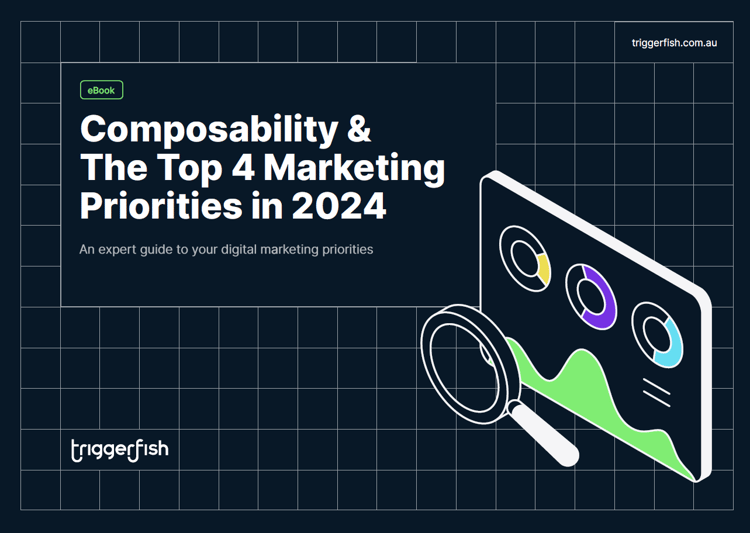Welcome to part 3 of our 5-part series that will explore the composable strategies and the top 4 marketing priorities in 2024.
With the current prominence of composable technologies, Chief Marketing Officers (CMOs), Chief Technology Officers (CTOs), and Chief Information Officers (CIOs), face a crucial business question: Are the technology-driven benefits for composable technologies aligned with business and marketing goals?According to Gartner, while composability is gaining traction, not all businesses are well-positioned to harness its full potential. Read related article Five Levels of Composability Readiness.
At Triggerfish, we’ve identified the top 4 marketing priorities that are crucial for CMOs and organisations assessing composable technologies in 2024.
These include:
- Personalisation Effectiveness
- Data-Driven Engagement
- Strategic Budget Allocation
- Modernising Team Structure
In this article, we will explore the second point above.
Collecting and leveraging customer data to drive user engagement across channels
Turning data into a business differentiator; it’s time to make the Customer Data Platform (CDP) a reality. Customer Data Platforms (CDPs) have revolutionised how businesses handle customer data. A CDP is a software that aggregates and organises customer data across various touchpoints into a single, unified customer database. This database is accessible to other systems, making it a valuable resource for personalised marketing and customer experience strategies.CDPs can significantly improve marketing strategies across traffic acquisition, customer engagement,
lead generation and conversion rates. By analysing collected data, businesses can identify the most
effective channels, understand customer journey bottlenecks, and optimise marketing efforts to
attract and convert more effectively. This leads to better resource allocation and marketing effectiveness.
According to Fortune Business Insights, the customer data platform market, valued at $1.75 billion in
2022, is expected to grow to $9.92 billion by 2030.
However, a Customer Data Platform is only as good as the data that it has in it. For a successful implementation, it’s important to ensure the CDP meets the following key capabilities and objectives:
- Unified Customer Data: Aggregated data from multiple business systems, de-duplicated and presented in a way that is contextual to the individual, not just the business unit.
- Real-time Capability: As customers move through the Life Stages, data is pushed to marketing systems in real-time, allowing marketers to execute during the “moments between”.
- Persistent: Current and historical data can be maintained and pushed to marketing systems.
- Democratised Open Access: The marketing team. related departments and marketing partners/agencies can be provided secure, controlled access to the right business and marketing data to better serve the customer by executing faster and delivering richer, more timely, personalised and automated campaigns.
- Packaged Software: Designed to work independently, under marketing control, within IT policy and with no limitations to future technology consolidation or investment.
- Breaks down silos: The business systems landscape has many purposeful silos of data. This solution unlocks data in those systems without removing it or exposing the business systems directly to marketing technologies.
Planning a successful CDP implementation
Failing the above, the CDP implementation will fall short and create a biased, incomplete view of customers, interaction context, insights and data needed to make impactful business decisions.According to Gartner, organisations face significant financial losses due to poor data quality, with an average cost of $12.9 million per year. In addition, poor-quality data can lead to increased complexity in data systems and negatively impact decision-making over time.
The first step in a CDP journey should be evaluating the organisation's digital and data maturity.
At Triggerfish, planning a successful CDP implementation starts with the below:
- Define objectives: Clearly define the objectives of the CDP initiative, including measurable key performance indicators (KPIs) and expected outcomes
- Identify stakeholders: Identify all stakeholders involved pre-, during and post-implementation, both internal and external, and define their roles and responsibilities.
- Plan resources: Determine what resources will be required for the project, including budget, personnel, and technology, and secure them appropriately.
- Develop timelines: Create a timeline that includes all key milestones, deadlines, and deliverables for the project, and ensure that it is realistic and achievable.
- Establish communication channels: Determine how communication will be handled between all stakeholders, including regular updates, progress, and necessary escalation
- Identify risks: Identify any potential risks that could impact the success of the project and develop contingency plans to address them if they occur.
- Monitor and adjust: Have an outcome measurement framework in place that continuously monitors progress against the established KPIs and objectives and makes adjustments as needed to ensure success.
- Celebrate success.
Triggerfish can conduct a Digital and Data Maturity assessment to help guide your internal conversations as you formulate and prioritise your use cases, business cases and objectives, processes and dependencies.
To continue reading about composability, download our eBook.



